How To Choose Non-diamond Engagement Rings That Make a Statement

There are several non-diamond engagement ring alternatives available. It all comes down to personal preference; an engagement ring should express your sense of fashion. Valuable colored gems like emeralds, sapphires, and rubies spring to mind when considering non-diamond centerpiece stones. Other than that, semi-precious stones are in style right now, including moonstone, Morganite, garnet, tourmaline, opal, topaz, and quartz, to name a few.
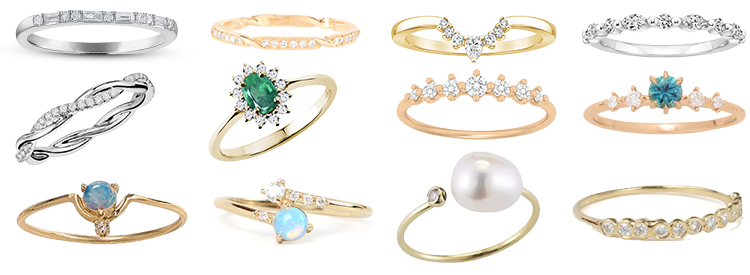
Another thing to consider when looking at diamond substitutes is synthetic possibilities like lab-created Moissanite or other diamond implants, which are affordable and mirror diamonds' appearance and brilliance.
Why Choose a Non-diamond Engagement Ring?
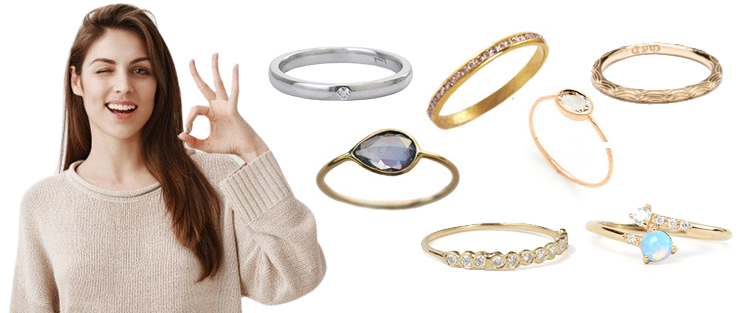
The non-diamond engagement rings most in demand are stunning and durable enough to be worn daily. Several gemstones can withstand everyday wear and tear better than others because people wear most engagement rings daily and seldom take them off. There are several reasons to choose a non-diamond engagement ring; some of these include the following;
Unique and Customized

Do you and your partner want to do your own thing and be unique? Do they enjoy colorful accents? Or do they like statement jewelry? In that case, a non-diamond engagement ring is an ideal choice.
Anyone searching for something more unconventional would love these kinds of engagement rings. The statement-making qualities of gemstone and non-diamond engagement rings make them stand out in myriad diamond jewelry.
Also very significant are gemstone engagement rings. You can present your significant other with a non-diamond engagement ring featuring their birthstone or perhaps your birthstone as the main stone to enable them to carry a memento of you!
Budget-friendly

In general, the price of gemstones per carat will be less than that of diamonds, which is one of the numerous benefits of choosing a non-diamond engagement ring. Gems are excellent if your companion desires a considerably larger center stone.
If your significant other adores the concept of an original antique engagement ring, this type of ring is immensely beneficial.
Environmentally Friendly Choice

Non-diamond engagement rings and lab-created diamonds offer a more ecologically friendly and culturally appropriate choice. This choice focuses mainly on environmentally conscious couples than diamond mining, which is undoubtedly not among the most environmentally friendly practices.
It's conceivable for the mining of gemstones to include unethical or irresponsible methods. Due to this, we highly recommend engagement rings from companies like Angara, Blue Nile, Catbird, Valley Rose, and Brilliant Earth that place a high value on ethical sourcing for their non-diamond rings.
What Is the Best Substitute for a Diamond?

Everyone is aware that diamonds are costly and demanding to pay for. Nevertheless, only some have the means to acquire a diamond ring, and not everyone who does not lack the means wants to do so. The four Cs—carat, color, clarity, and cut—are also essential to check for when purchasing diamond jewelry since they will affect the diamond's cost and quality.
Fortunately, these diamond substitutes provide diamond splendor at a far lower cost. Diamond substitutes are essentially gemstones that, at first appearance, resemble diamonds; as a result, many consumers choose to purchase these look-alikes.
Topaz
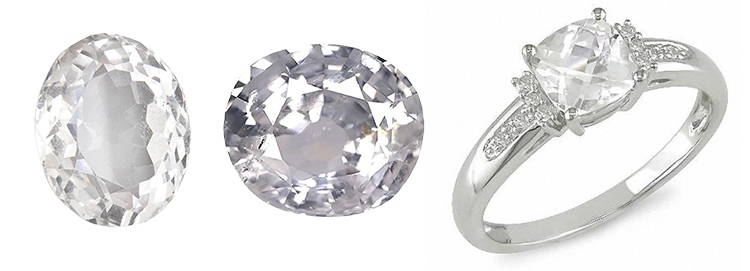
Topaz jewelry rose in popularity throughout the 18th century in aristocratic Europe, where the stone stood for wealth and authority. According to ancient Roman and Egyptian beliefs, it symbolizes strength, protection, and harmony in daily life. Furthermore, the topaz has been used throughout history to dispel curses and prophesy a long life full of good fortune and beauty. It's a fantastic option for people hoping to save money on engagement rings.
This firm, naturally occurring stone has an extraordinary gray-white shine and is incredibly affordable. Topaz comes in a wide range of sizes and shapes and has a sophisticated and beautiful appearance. With a hardness rating of 8 out of 10 on the Mohs scale, it can withstand scratches and maintain its beauty indefinitely.
White Topazes appear white at first look; however, they are colorless. However, they frequently resemble glass and can seem milky if the stone contains impurities.
Amethyst

According to ancient Greek mythology, the deity Dionysus was the first creature ever to discover the purple gemstone. The purple color of this non-diamond gem symbolized spiritual purity. Its scarlet and purple tones conveyed the chastening and cleansing effects of pain and suffering.
Amethyst is the ideal stone for the unusual bride because of its rich violet color. You may get a considerable amethyst for a price considerably lower than a diamond.
Despite the color's beauty, it's vital to remember that amethyst is not as durable as some other colorful gemstones. It's more brittle and susceptible to injury. Because it rates a seven on the Mohs scale, I advise against wearing it frequently. Amethyst can remain your pick, provided you're prepared to maintain it and be particularly cautious.
Moissanite
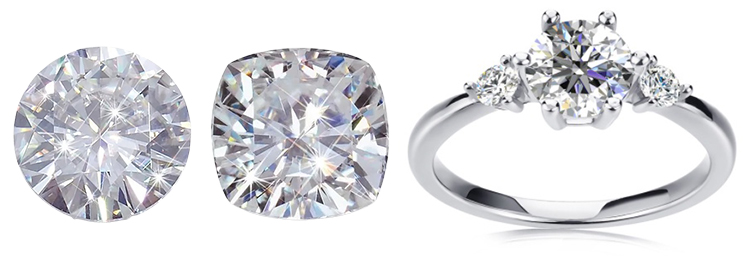
Dr. Henri Moissan, a French scientist who won the Nobel Prize, discovered Moissanite more than 120 years ago. The gem's physical toughness has a dual symbolic meaning: dedication and steadfastness.
Moissanite is your ideal alternative if you're looking for something that sparkles more than a diamond. Due to their 9.5 Mohs hardness, jewelers first mistook them for diamonds. Right after diamonds, they are the second-hardest gemstone in the world, and because of their intense rainbow flashes, Moissanite glows even more brilliantly than a diamond.
Although Moissanites are typically colorless, they can have a yellow or greenish tinge. Not only can Moissanite gemstones resemble diamonds in appearance and hardness, but they are also considerably less expensive than diamonds, making them highly accessible.
Pearl
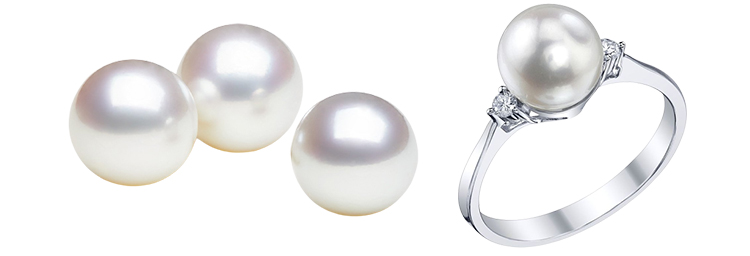
Since Emma Stone's fiancé, Dave McCary, gave her a stunning pearl engagement ring, everyone has been talking about pearl engagement rings. Pearls are a lovely option for your engagement since they stand for faithfulness, honesty, generosity, and purity.
Most engagement rings feature prong-set center stones, which means that small bits of metal hold the stone in place. They are a classy and distinctive option for an engagement ring. Additionally, they cost a lot less than diamonds.
Unlike other engagement rings, pearl rings frequently don't have prong settings and adhere the stone to the band with powerful glue.
Emerald
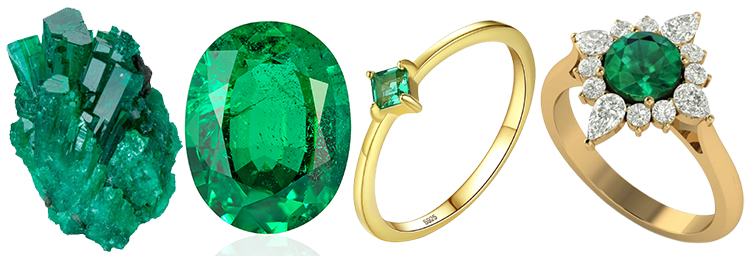
Egypt's first recorded emerald mines were active between 330 BC and the 1700s. The historical entity most associated with the love of emerald jewels is presumably Cleopatra. In addition to representing nobility, emeralds also represent intelligence, eloquence, and insight.
Emeralds are a timeless choice that can significantly enhance your jewelry collection with their stunning green tint. They are available in several forms you can readily alter to fit into the ring of your dreams.
Emeralds have a hardness rating of around 7.5 on the Mohs scale; therefore, they need a little more care and attention when worn or preserved. The ideal emerald shade is apparent, medium in intensity, yet not too dark or pale.
It's also essential to find out the amount of oil used to polish your emerald, as the appearance of stones treated with a lot of oil would deteriorate over time.
Opal

The renowned archaeologist Louis Leakey discovered the first known opal objects in a Kenyan cave. That was around 4000 B.C., and they most likely originated in Ethiopia.
Romans called it the Cupid Stone and considered it the most valuable and potent stone and a representation of love. Because of this, it might inspire love and romance. It symbolizes honesty, purity, and optimism.
The uniqueness of opals makes them a more and more desirable diamond substitute. A beautiful display of hues in opals, even though they don't seem like diamonds, makes them stand out from other gems on the market.
Opals don't have the same hardness level as diamonds, with a Mohs scale grading of around 5.5 and 6.5. They can rival their brilliance and come in various hues, including red, blue, brown, dark gray, orange, and milky white.
Opals never match, making each one special, unlike diamonds, where it is possible to find two that are aesthetically and structurally similar. Opals are also good-quality stones at affordable prices.
Morganite

In 1911, the Morganite was initially identified in Madagascar and named "Pink Beryl." To honor his benefactor, Philanthropist, and New York financier John Pierpont Morgan, renowned gemmologist George Frederick Kunz changed the name of the gemstone to "Morganite."
Morganite is a fashionable alternative to diamonds right now. It is a feminine pinkish gemstone that mimics the ultra-luxurious pink diamond. The stone's light tint makes it wearable and flexible, and there are many ways to use it.
According to Sassone, Morganite and aquamarine are similar since they belong to the same family. Although it's okay to wear them often, they require more care than diamonds. This gemstone has a hardness of around 7.5. Morganite's gentle pinkish tone symbolizes romance, innocence, tenderness, and love.
The Most Popular Non-diamond Engagement Rings
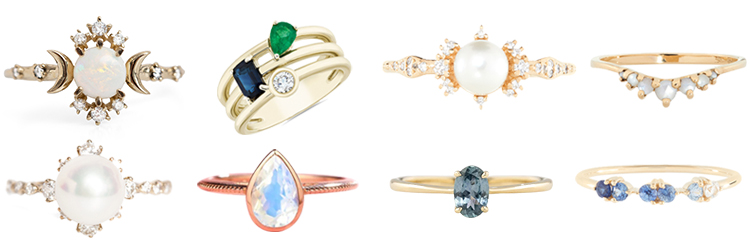
For this segment, I'll share some of the most beautiful and popular non-diamond engagement rings available and what you need to know about these engagement rings.
Celestial-Inspired Opal Engagement Ring

No engagement ring is more romantic if your significant other enjoys astronomy than this one. This unique engagement ring's cosmic, starry night feel is gorgeous! The ring has the appearance of an entire moon cycle because of the opal, and the crescent moons on the side evoke the feeling of a full moon.
Geometric Triple Band Gemstone Stack Ring
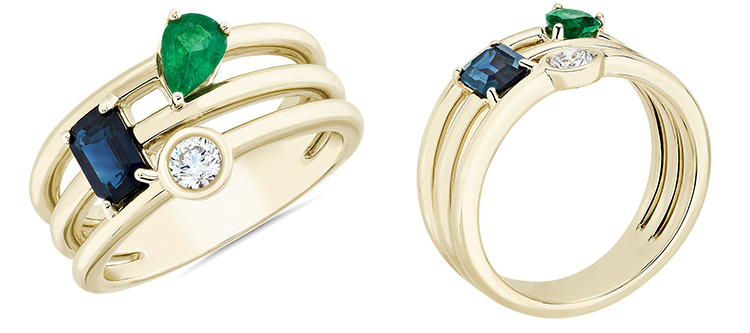
Why choose just one engagement ring when you can stack three instead? This triple stack gemstone ring is a favorite as it's unique, entertaining, and stands out. The stacking trend is enormous, and we adore how stylish and upscale this ring looks.
Majestic Pearl and Gold Show-Stopper

The pearl on this ring is more petite and gives off a more delicate feeling, giving it a more tarnished appearance. This engagement ring contains regal-looking accent stones that elevate the pearl's center stone above a pedestal.
Ethereal Winter Pearl Engagement Ring

This pearl engagement ring is a stunning accessory. This ring's unconventional yet timeless design highlights a good pearl center stone. This ring's pearl has the most beautiful light-catching quality, and its exquisite floral-inspired features make it appear made from 18K gold.
Curved Band Mother of Pearl Alternative Engagement Ring

This mother-of-pearl ring conveys elegance and luxury. It has a subdued, subtle appearance, and I adore the pearl accents' radiance. It's incredible how this ring can double as a stunning wedding band and the ideal non-diamond engagement ring.
Montana Sapphire Solitaire with Satin Gold Band

This Montana sapphire engagement ring's blue-green gemstone has a tint that makes us think of an alpine lake, which is very appropriate given that it isn't a diamond. Furthermore, the matte-like silky texture on the gold band is adorable.
Pear Shaped Blue Moonstone Engagement Ring

Everything about this pear-shaped blue moonstone engagement ring denotes modesty and elegance. The rose gold beaded decorations on the ring give it a handmade quality. Additionally, moonstones are among the most cost-effective gemstones for the main gem on your engagement ring.
Blue Gradient Gemstone Ring with Paired Stones

The fact that this non-diamond and non-gemstone engagement ring emphasizes color and design instead of a lone diamond center stone is among its trendiest features. Since pairs of sapphires paired up on the band provide some of the most distinctive engagement rings you could pick from.
Conclusion
When choosing the best non-diamond engagement ring, there is no general, correct answer. The ideal ring is mainly dependent on personal preference. The good thing is that there are many mind-blowing and outstanding options to choose from.


Leave a Comment